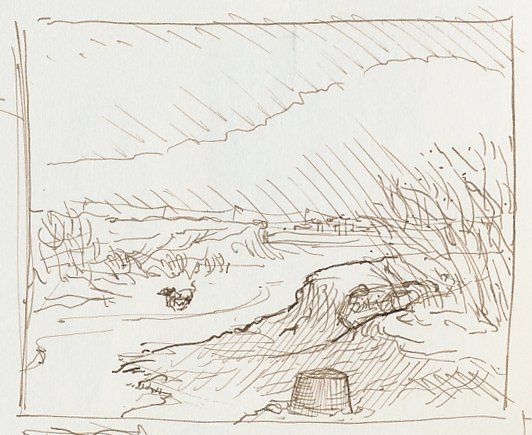There’s a kind of Chinese landscape painting that acts as a miniature model of the universe, depicting the progression of its energies as they move through the five elements and back—an invisible eternal principle manifesting as a picture. Within these structured models there would be a small figure walking a path or fixing a net or some such, dwarfed by the cosmic landscape.

I loved this idea, with its vast view and the anonymous figures, cool and removed but affectionate at the same time. Non-dual Romanticism, a way to join heaven and earth with humanity. Some western artists seem to share this view, though more subjectively. Turner’s figures are there to look small. Corot made landscape after landscape with the same red-shirted peasant standing near the center.
When I started making landscapes, I populated them with animals rather than peasants. I didn’t want the extra complexity—just a mind, some sense of a consciousness experiencing the world. Something to activate it. Sometimes it was a bunny. But mostly I drew dogs. Dogs are easy stand-ins for people but skirt a lot of cultural baggage. Experience pared down, a little mind in big space, a little point of awareness.

Some of these became loose metaphors for meditation. A dog running from an owner. A sleeping, thirsty, scared, angry dog—whatever. One was a sketch of a dog tied to a stake with a circle of grass worn out by its movement against the chain, a nod to the karmic habitual patterns discussed in Buddhist teaching. And then the first of several “drunkard’s dog” paintings. It showed a dog alone in a speedboat cruising in a circle—the cyclical nature of relative existence, samsara, characterized by ignorance and suffering. The pilot fell overboard drunk, and the helpless dog of habit remains in the boat. It turned into a recurrent image—not autobiography, but like an emblem with many uses.

The Buddhist model of the five skandhas (five heaps of existence) is represented by four people in a boat. The boat is the body, and the people are the four categories of internal experience. They comprise everything that we ever think of as real, but they’re all illusory and transient. Four people become four legs. The boat seems to be separate from the sea, but it is compound and created so it’s sure to sink.

Buddhist mnemonic images are so juicy and time-tested, and they’d never been subjected to the West’s program of thematic experimentation and variation. It’s not a matter of mining a tradition of symbols for fresh imagery. It’s a way of joining a view with the activity of painting. And, it’s not even as intentional as that.
